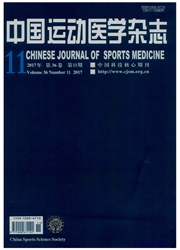

 中文摘要:
中文摘要:
目的:探讨体力活动水平预测代谢综合征(MS)相关风险因素的有效性。方法:对246名40~49岁健康中年男性进行问卷调查和相关生理生化指标测试.观察体力活动量和强度两个因素对MS相关风险因素的影响。根据国际体力活动调查问卷(IPAQ)的标准将体力活动量划分为低、中、高3种等级;体力活动强度划分为低、中、大强度3种等级:MS依据中国成人血脂异常防治指南的标准界定。结果:(1)随着体力活动量等级的提高,MS的发病率和相关风险指标均未呈逐级下降趋势。体力活动量各等级之间的相关风险因素无显著性差异(P〉0.05);(2)随着体力活动强度等级的提高,MS发病率和相关风险指标呈显著性下降,其中中等强度等级组发病率和相关风险指标最低。结论:(1)体力活动量与MS相关风险因素之间无相关性,不能作为预测MS发病率和相关风险因素的评价指标:(2)中等强度以上的体力活动水平有利于MS发病率和相关风险因素指标的改善.体力活动强度可以作为评定MS相关风险因素的评价指标。
 英文摘要:
英文摘要:
Objective The cross-sectional study was to analyze the validity of physical activity (PA) levels for predicting metabolic syndrome (MS)risk factors. Methods A total of two hundred and forty six 40-49 years old men were included in this study. PA volume and PA intensity were assessed with the International Physical Activity Questionnaire (IPAQ)and they were categorized into low ,moderate and high levels corresponding to 〈 600,600 ≤X ≤3000 and ≥ 3000 MET-minutes/week. Metabolic syndrome was defined according to the Guidelines on Prevention and Treatment of Blood Lipid Abnormality in Chinese Adults. Results There was no significant association between PA volume and MS risk factors. With increasing of PA intensity,the incidence and risk factors of MS decreased significantly,and the lowest incidence and risk factors were observed in the moderate PA level group. Conclusion Moderate and high levels of PA intensity rather than PA volume strongly relates to MS risk factors.
 同期刊论文项目
同期刊论文项目
 同项目期刊论文
同项目期刊论文
 期刊信息
期刊信息
